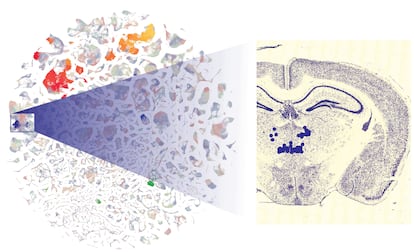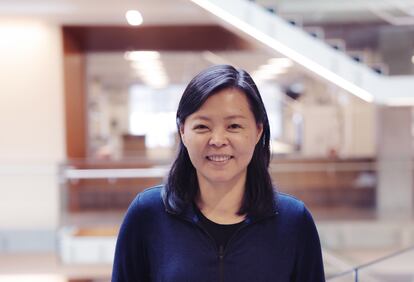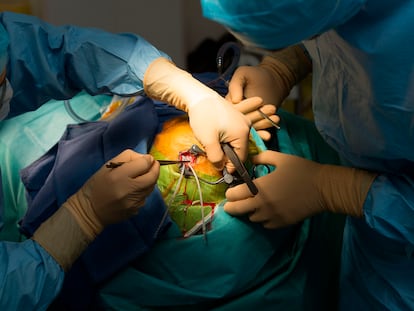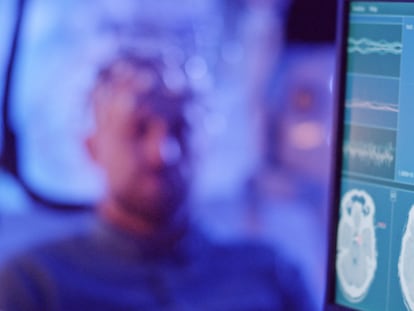With a complete map of a mouse brain, scientists hope to understand the human mind
A billion-dollar consortium has revealed for the first time the deep organization at play within a mammal’s thinking organ

One day, in the summer of 2011, the history of science changed forever. In an English mansion called Chicheley Hall, two dozen brain experts and specialists in the study of structures (capable of measuring millionths of a millimeter) met to discuss possible collaborations. The Spanish neuroscientist Rafael Yuste stood up and proposed analyzing all the neurons in the brain, one by one. Investigating just a handful, he proclaimed, was like trying to watch television by looking at a single pixel. This idea sounded quixotic, but it ultimately became the BRAIN Initiative, a U.S. government project that already has a budget of around $3 billion. The working group’s latest results — published this past Wednesday — are impressive: the first almost-complete map of a mouse’s brain. As a result of this, the dream of conquering the organ that is responsible for human thought is closer than ever before.
The Spanish doctor Santiago Ramón y Cajal began this work in 1888, attempting to create a map of the brain. He worked alone, out of his house in Barcelona. He began with poultry organs, meaning that his family often had chicken for dinner. Then, he moved on to mice, rabbits… and the still-warm corpses of children, collected from institutions in Madrid. Cajal perfected a chemical cocktail to stain tissues, becoming the first researcher to observe (through his microscope) that the nervous system was made up of individual cells: neurons. For decades, he drew them by hand, classifying them according to their convoluted shapes.
This week’s results show how far science has come. A consortium of hundreds of scientists has used cutting-edge technologies to automatically analyze more than four million cells, revealing what type they are and — for the first time — exactly where they are located. It’s the most complete map of the brain of a mammal.
Rafael Yuste considers these results — which have been published in a dozen studies in the prestigious journal Nature — to be “spectacular.” The Columbia professor gushes that “having a list of all the neurons [is like having] a Rosetta Stone of the brain,” alluding to the engraved rock that allowed Egyptian hieroglyphs to be deciphered in the 19th century.
All the cells of the same animal share the same recipe book — DNA — with the instructions to make the bricks of life: proteins. However, in an individual, there are thousands of very different types of cells, from neurons in the brain to red blood cells. The explanation is that each cell reads different pages of that same recipe book.
Chinese-American biophysicist Xiaowei Zhuang, from Harvard University, invented a new technology in 2015, called MERFISH. It’s capable of locating the position of each cell and finding out which pages of DNA are being read within them. This method is known as “spatial transcriptomics.” Yuste says that Zhuang deserves the Nobel Prize. “She’s one of the best scientists of our generation,” he affirms.
The American consortium — led by neuroscientist Hongkui Zeng and Xiaowei Zhuang herself — has described 34 classes and more than 5,300 types of cells in the mouse brain, an organ that is only the size of a pea. It barely weighs half-a-gram, but contains about 70 million neurons. However, its complexity pales before the most sophisticated structure on the face of the Earth: the human brain, which has some 86 billion neurons, with trillions of connections between them.

This past March, the Spanish biologist Albert Cardona and his Croatian colleague Marta Zlatic achieved the first map of a complete brain. It was of the fruit fly larva, a structure with only 3,016 neurons and 548,000 connections — also called synapses — between them. “The great work that’s been published is spectacular: it represents an almost complete map of the mouse brain,” Cardona celebrates, from the Laboratory of Molecular Biology in Cambridge (U.K.). “Its importance lies in the fact that the mouse is the most studied animal in laboratories, [often used] to model the functioning of the human brain and its diseases. From now on, all studies in mice and other species — such as monkeys and us humans — can be carried out on the shoulders of this [map],” the biologist notes.
Still, neuroscientist Hongkui Zeng acknowledges that there are difficulties. “We won’t have a synapse-to-synapse map of the human brain in the near future. We still don’t have technology with nanometer precision that can be scaled to the size of the human brain. And the dataset would be so huge that — at the moment — it would be almost impossible to analyze,” explains Zeng, director of the Allen Institute for Brain Sciences in Seattle, Washington.
The American physicist Emerson Pugh — who died in 1981 — captured this paradox in a playful phrase: “‘If the human brain were so simple that we could understand it, we would be so simple that we couldn’t.” Zeng, however, isn’t so pessimistic. “I believe that we can understand many aspects of the functioning of the human brain, such as sensations, movement, different emotional states and certain degrees of intelligence,” the researcher opines.
The new results can be consulted in a public database, the Allen Brain Cell Atlas. Users can search for specific types of cells and their exact locations. The authors argue that this torrent of data will help illuminate a multitude of disorders, such as autism, schizophrenia, multiple sclerosis, anorexia nervosa and tobacco addiction.

In 1891, Santiago Ramón y Cajal began to include little arrows in his drawings of neurons, to mark the direction in which the information traveled. Cajal postulated that nerve cells receive impulses through branches called dendrites, transmitting them through an elongated nerve fiber known as an “axon.” He had discovered the basic ingredients of human thought. His disciple, Rafael Lorente de No, later articulated the idea that the brain is organized into a series of neurons, which are interrelated via circuits.
This past Wednesday’s results include data that was unimaginable a century ago. The mouse map shows which neurons have the possibility of connecting with certain others — the so-called “projectome.” It reveals “how information travels and is transformed in the brain,” in Cardona’s words.
Spanish neuroscientist Óscar Marín directs the Center for Neurodevelopmental Disorders at King’s College London. He’s also optimistic about the latest studies. “We still don’t have a complete map of a brain, but we see that possibility getting closer and closer. And, over time, we’ll also achieve it in humans,” he predicts. In 2021, researchers from the BRAIN Initiative published the first draft of the mouse’s brain cell atlas. In October of this year, the consortium reported the first results of these techniques with the human brain.
Marín — who belongs to the prestigious Royal Society of the United Kingdom — cautions that a single atlas won’t be enough. “Even if we achieve a complete map of all cell types in the brain, there will always be differences between individuals of the same species. I believe that these interindividual differences are an important part of biology… although I think that, with the same methods described in these [recently-published works], we’ll soon be able to reproduce these results in different individuals,” Marín affirms. Every human brain is original, after all.
Sign up for our weekly newsletter to get more English-language news coverage from EL PAÍS USA Edition
Tu suscripción se está usando en otro dispositivo
¿Quieres añadir otro usuario a tu suscripción?
Si continúas leyendo en este dispositivo, no se podrá leer en el otro.
FlechaTu suscripción se está usando en otro dispositivo y solo puedes acceder a EL PAÍS desde un dispositivo a la vez.
Si quieres compartir tu cuenta, cambia tu suscripción a la modalidad Premium, así podrás añadir otro usuario. Cada uno accederá con su propia cuenta de email, lo que os permitirá personalizar vuestra experiencia en EL PAÍS.
¿Tienes una suscripción de empresa? Accede aquí para contratar más cuentas.
En el caso de no saber quién está usando tu cuenta, te recomendamos cambiar tu contraseña aquí.
Si decides continuar compartiendo tu cuenta, este mensaje se mostrará en tu dispositivo y en el de la otra persona que está usando tu cuenta de forma indefinida, afectando a tu experiencia de lectura. Puedes consultar aquí los términos y condiciones de la suscripción digital.











































